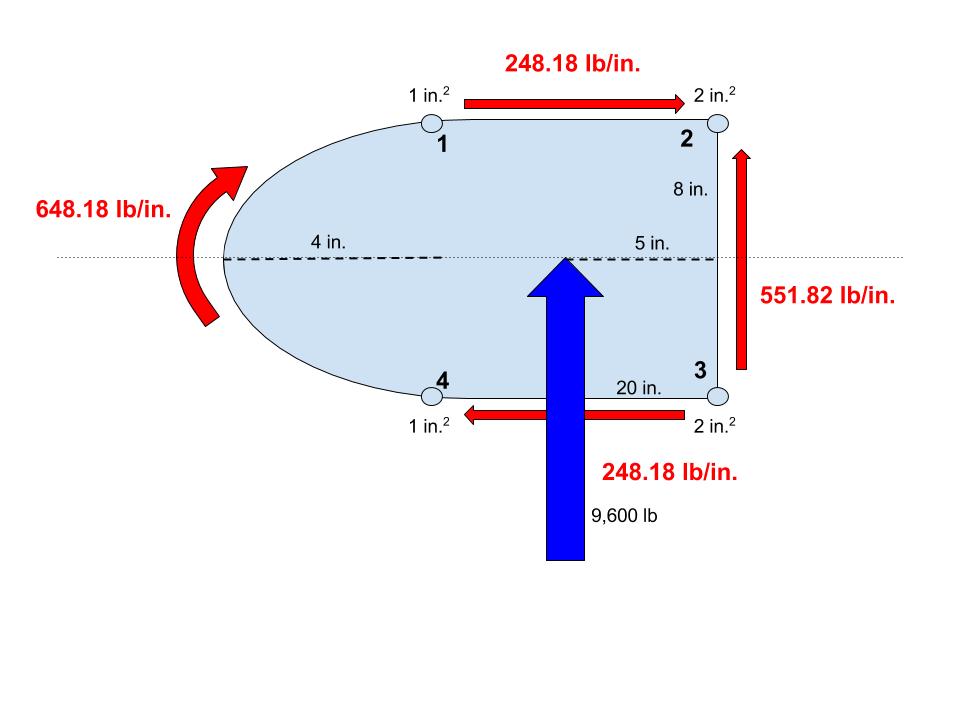Shear flow on:
[Wikipedia]
[Google]
[Amazon]
In

 Unlike in
Unlike in
Horizontal shearing stress
Shear flow
Solid mechanics Fluid dynamics
solid mechanics
Solid mechanics (also known as mechanics of solids) is the branch of continuum mechanics that studies the behavior of solid materials, especially their motion and deformation (mechanics), deformation under the action of forces, temperature chang ...
, shear flow is the shear stress
Shear stress (often denoted by , Greek alphabet, Greek: tau) is the component of stress (physics), stress coplanar with a material cross section. It arises from the shear force, the component of force vector parallel to the material cross secti ...
over a distance in a thin-walled structure.Higdon, Ohlsen, Stiles and Weese (1960), ''Mechanics of Materials'', article 4-9 (2nd edition), John Wiley & Sons, Inc., New York. Library of Congress CCN 66-25222 In fluid dynamics
In physics, physical chemistry and engineering, fluid dynamics is a subdiscipline of fluid mechanics that describes the flow of fluids – liquids and gases. It has several subdisciplines, including (the study of air and other gases in motion ...
, shear flow is the flow ''induced'' by a force in a fluid.
In solid mechanics
For thin-walled profiles, such as that through a beam orsemi-monocoque
The term semi-monocoque or semimonocoque refers to a stressed shell structure that is similar to a true monocoque, but which derives at least some of its strength from conventional reinforcement. Semi-monocoque construction is used for, among o ...
structure, the shear stress
Shear stress (often denoted by , Greek alphabet, Greek: tau) is the component of stress (physics), stress coplanar with a material cross section. It arises from the shear force, the component of force vector parallel to the material cross secti ...
distribution through the thickness can be neglected. Furthermore, there is no shear stress in the direction normal to the wall, only parallel. In these instances, it can be useful to express internal shear stress as shear flow, which is found as the shear stress multiplied by the thickness of the section. An equivalent definition for shear flow is the shear force ''V'' per unit length of the perimeter around a thin-walled section. Shear flow has the dimensions of force per unit of length. This corresponds to units of newtons per meter in the SI system and pound-force
The pound of force or pound-force (symbol: lbf, sometimes lbf,) is a unit of force used in some systems of measurement, including English Engineering units and the foot–pound–second system.
Pound-force should not be confused with poun ...
per foot in the US.
Origin
When a transverse force is applied to a beam, the result is variation in bending normal stresses along the length of the beam. This variation causes a horizontal shear stress within the beam that varies with distance from the neutral axis in the beam. The concept of complementary shear then dictates that a shear stress also exists across the cross section of the beam, in the direction of the original transverse force. As described above, in thin-walled structures, the variation along the thickness of the member can be neglected, so the shear stress across the cross section of a beam that is composed of thin-walled elements can be examined as shear flow, or the shear stress multiplied by the thickness of the element.Applications
The concept of shear flow is particularly useful when analyzing semi-monocoque structures, which can be idealized using the skin-stringer model. In this model, the longitudinal members, or stringers, carry only axial stress, while the skin or web resists the externally applied torsion and shear force. In this case, since the skin is a thin-walled structure, the internal shear stresses in the skin can be represented as shear flow. In design, the shear flow is sometimes known before the skin thickness is determined, in which case the skin thickness can simply be sized according to allowable shear stress.
Shear center
For a given structure, the shear center is the point in space at which shear force could be applied without causing torsional deformation (e.g. twisting) of the cross-section of the structure. The shear center is an imaginary point, but does not vary with the magnitude of the shear force - only the cross-section of the structure. The shear center always lies along the axis of symmetry, and can be found using the following method: # Apply an arbitrary resultant shear force # Calculate the shear flows from this shear force # Choose a reference point ''o'' an arbitrary distance ''e'' from the point of application of the load # Calculate the moment about o using both shear flows and the resultant shear force, and equate the two expressions. Solve for ''e'' # The distance ''e'' and the axis of symmetry give the coordinate for the shear center, independent of the shear force magnitude.Calculating shear flow
By definition, shear flow through a cross section of thickness t is calculated using , where . Thus the equation for shear flow at a particular depth in a particular cross-section of a thin-walled structure that is symmetric across its width is : where : ''q'', the shear flow : ''V''''y'', the shear force perpendicular to the neutral axis ''x'' at the cross-section of interest : ''Q''''x'', the first moment of area (aka statical moment) about the neutral axis ''x'' for the cross section of the structure above the depth in question : ''I''''x'', the second moment of area (aka moment of inertia) about the neutral axis ''x'' for the structure (a function only of the shape of the structure)In fluid mechanics
 Unlike in
Unlike in solid mechanics
Solid mechanics (also known as mechanics of solids) is the branch of continuum mechanics that studies the behavior of solid materials, especially their motion and deformation (mechanics), deformation under the action of forces, temperature chang ...
where ''shear flow'' is the shear stress force per unit length, in fluid mechanics
Fluid mechanics is the branch of physics concerned with the mechanics of fluids (liquids, gases, and plasma (physics), plasmas) and the forces on them.
Originally applied to water (hydromechanics), it found applications in a wide range of discipl ...
, ''shear flow'' (or ''shearing flow'') refers to adjacent layers of fluid moving parallel to each other with different speeds. Viscous
Viscosity is a measure of a fluid's rate-dependent resistance to a change in shape or to movement of its neighboring portions relative to one another. For liquids, it corresponds to the informal concept of ''thickness''; for example, syrup h ...
fluids resist this shearing motion. For a Newtonian fluid
A Newtonian fluid is a fluid in which the viscous stresses arising from its flow are at every point linearly correlated to the local strain rate — the rate of change of its deformation over time. Stresses are proportional to the rate of cha ...
, the stress exerted by the fluid in resistance to the shear is proportional to the strain rate or shear rate
In physics, mechanics and other areas of science, shear rate is the rate at which a progressive shear strain is applied to some material, causing shearing to the material. Shear rate is a measure of how the velocity changes with distance.
Simple ...
.
A simple example of a shear flow is Couette flow, in which a fluid is trapped between two large parallel plates, and one plate is moved with some relative velocity to the other. Here, the strain rate is simply the relative velocity divided by the distance between the plates.
Shear flows in fluids tend to be unstable
In dynamical systems instability means that some of the outputs or internal state (controls), states increase with time, without bounds. Not all systems that are not Stability theory, stable are unstable; systems can also be marginal stability ...
at high Reynolds numbers, when fluid viscosity is not strong enough to dampen out perturbations to the flow. For example, when two layers of fluid shear against each other with relative velocity, the Kelvin–Helmholtz instability
The Kelvin–Helmholtz instability (after Lord Kelvin and Hermann von Helmholtz) is a fluid instability that occurs when there is shear velocity, velocity shear in a single continuum mechanics, continuous fluid or a velocity difference across t ...
may occur.
Notes
References
*Riley, W. F. F., Sturges, L. D. and Morris, D. H. ''Mechanics of Materials.'' J. Wiley & Sons, New York, 1998 (5th Ed.), 720 pp. {{ISBN, 0-471-58644-7 *Weisshaar, T. A. ''Aerospace Structures: An Introduction to Fundamental Problems.'' T.A. Weisshaar, West Lafayette, 2009, 140pp. *''Aerospace Mechanics and Materials.'' TU Delft OpenCourseWare. 11/22/16.External links
Horizontal shearing stress
Shear flow
Solid mechanics Fluid dynamics